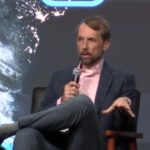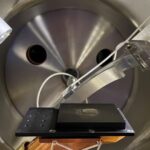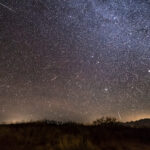The moon has no significant atmosphere, no weather, and no wind. Yet it faces an invisible bombardment more relentless than any terrestrial storm, a constant rain of micrometeoroids, tiny fragments
phys.org10- Page
A newly discovered, remarkably well-preserved impact crater is shedding fresh light on how extraterrestrial bodies collide with Earth.
Intense solar storms responsible for breathtaking auroras across the U.S. delayed the launch of Blue Origin’s big new rocket Wednesday.
The discovery of a superheated star factory that forms stars 180 times faster than our own Milky Way could help solve a long-standing puzzle about how galaxies grew so quickly
It’s a beautiful clear night. The stars are out and the moon looks breathtaking against the sky, so you reach for your phone to take a snap. The results are,
At a young age, we’re told how the sun warms Earth and makes life possible. That idea sticks with most of us for life. But when we want to understand
As a true milestone on the path to autonomous space systems, a research team at Julius-Maximilians-Universität Würzburg (JMU) has successfully tested an AI-based attitude controller for satellites directly in orbit—a
Space dust provides more than just awe-inspiring pictures like the Pillars of Creation. It can provide the necessary materials to build everything from planets to asteroids. But what it actually
There are no confirmed exomoons, moons orbiting distant exoplanets in other solar systems. There are a few candidates, but none have passed the threshold and been accepted as confirmed. But
New Glenn, the towering rocket built by Jeff Bezos’s space company Blue Origin, is set to take off on its second mission Sunday as competition intensifies with Elon Musk’s SpaceX.
-
 012024 in Review: Highlights from NASA in Silicon Valley
012024 in Review: Highlights from NASA in Silicon Valley -
 02Panasonic Leica Summilux DG 15mm f/1.7 ASPH review
02Panasonic Leica Summilux DG 15mm f/1.7 ASPH review -
 03From Polymerization-Enabled Folding and Assembly to Chemical Evolution: Key Processes for Emergence of Functional Polymers in the Origin of Life
03From Polymerization-Enabled Folding and Assembly to Chemical Evolution: Key Processes for Emergence of Functional Polymers in the Origin of Life -
 04How New NASA, India Earth Satellite NISAR Will See Earth
04How New NASA, India Earth Satellite NISAR Will See Earth -
 05And Thus Begins A New Year For Life On Earth
05And Thus Begins A New Year For Life On Earth -
 06Astronomy Activation Ambassadors: A New Era
06Astronomy Activation Ambassadors: A New Era -
07SpaceX launch surge helps set new global launch record in 2024




